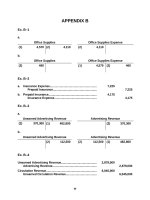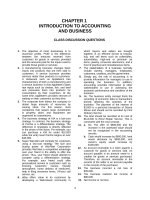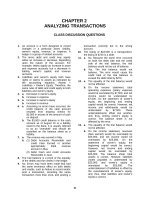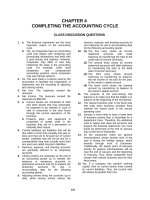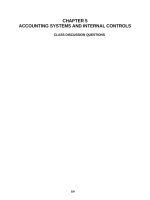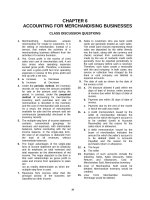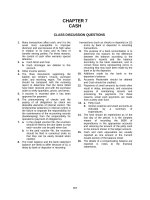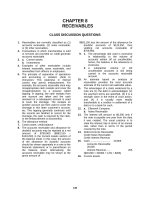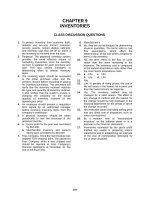Solution manual investments 10th by jones ch02
Bạn đang xem bản rút gọn của tài liệu. Xem và tải ngay bản đầy đủ của tài liệu tại đây (183.43 KB, 12 trang )
Chapter 2:
Investment Alternatives
CHAPTER OVERVIEW
The purpose of Chapter 2 is to provide an overview of the
major types of financial assets available to investors and
discussed in later chapters. It also develops the important
alternatives of direct and indirect investing, thereby providing
the foundation for Chapter 3, which covers indirect investing
through investment companies.
Obviously, these assets cannot be discussed in detail in
this chapter; however, it is important for students to be exposed
to the major types of financial assets early in the course in
order for them to understand the basics of alternative investment
opportunities. For example, if an instructor were to refer to an
example or concept involving a call option or a convertible
security, the student may have no idea what is being discussed.
Thus, this chapter seeks to provide basic information about
financial assets at the outset so that students are prepared to
handle basic discussions of investing during the course.
Chapter 2 first discusses the non-marketable alternatives
available to investors, such as savings accounts, because many
students have encountered these already. Also, they offer a good
contrast to the marketable securities, which are the focus of the
text.
Money market securities are discussed briefly, and in table
format. An important reason for this discussion is that these
assets typically are owned by individual investors in the form of
money market mutual funds.
Chapter 2 concentrates on the major capital market assets,
bonds and stocks, while providing a very brief coverage of
derivative securities.
The idea of indirect investing--the ownership of investment
company shares--is introduced in Chapter 2 in Figure 2-1. This
is because of the important alternative that such ownership
provides all investors--they can turn their funds over to a
mutual fund or closed-end company and not have to make investment
decisions. It is desirable for students to think about this
13
alternative early in their study. Many investors will opt for a
combination of direct and indirect investing, and this
alternative needs to be explained early in the course. Chapter 3
is devoted to indirect investing and provides a detailed
discussion of investment companies.
CHAPTER OBJECTIVES
To provide an overview of the major financial assets
available to investors and discussed in subsequent chapters.
To explain in some detail the financial assets of importance
to most investors, bonds, and stocks.
To explain investors’ alternatives, which consist of direct
investing, indirect investing, or, as is often done, a
combination of the two.
14
MAJOR CHAPTER HEADINGS [Contents]
Organizing Financial Assets
[invest directly and indirectly in money market, capital
market and other types of securities]
An International Perspective
[why this is important in today's investing environment;
typically done through investment companies]
Non-marketable Financial Assets
[savings accounts; certificates of deposit (CDs); money
market deposit accounts (MMDAs); U. S. government savings
bonds--key features summarized in table form]
Money Market Securities
[discussion of important money market securities in table
form; emphasis on Treasury bills as the risk-free (RF) rate]
Fixed-Income Securities
Bonds
[definition; characteristics--par value, maturity, zero
coupon bond, call feature, legal nature of bonds]
Types of Bonds
[Treasuries; Federal Agencies; Municipals; Corporates;
debentures, convertible bonds, bond ratings]
Asset-backed Securities
[definition, examples; securitization trends; why investors
buy asset-backed securities]
Equity Securities
Preferred Stock
[definition; characteristics; new forms]
Common Stock
15
[definition; characteristics--book value, market value,
dividends, dividend yield, payout ratio, stock dividends and
stock splits, the P/E ratio; investing internationally in
equities]
Derivative Securities
[Corporate-created securities: warrants; Options; Futures
Contracts]
Options
[definition; very brief basics of puts and calls]
Futures Contracts
[definition; purposes]
Appendix 2-A Taxes and Investing
[a brief discussion of marginal tax rates and capital gains]
POINTS TO NOTE ABOUT CHAPTER 2
Tables and Figures
Table 2-1 outlines the major non-marketable financial assets
in order that this topic can be covered efficiently.
Table 2-2 discusses the major money market securities in
table format, relieving the student and instructor from even more
tedious details in the body of the chapter. This table contains
the relevant facts about these assets, and further elaboration is
not beneficial at this point. THE IMPORTANT POINT TO STRESS IS
THAT MOST INDIVIDUAL INVESTORS WILL OWN THESE ASSETS INDIRECTLY
THROUGH MONEY MARKET MUTUAL FUNDS.
Figure 2-1 is useful for organizing financial assets into
one diagram. It illustrates both direct and indirect investing.
Figure 2-2 contains a basic summary of S&P debt rating
definitions.
Box Inserts
16
Box 2-1 is a discussion of options, focusing on LEAPs.
Options are briefly covered in Chapter 2 along with other
investment alternatives, and this allows the instructor to expand
somewhat more on options early in the course. LEAPS illustrates
the variety of financial assets available to investors—
previously, we had only short-term options on the organized
exchanges, and now we have both short-term and these longer-term
options. This boxed insert also illustrates the leverage
available with options, as well as their wasting-asset nature.
17
ANSWERS TO END-OF-CHAPTER QUESTIONS
2-1.
Marketable securities are classified into money market or
capital market instruments.
Money market instruments are short-term, highly
liquid, low risk securities
Capital market instruments are long-term instruments
of higher risk and varying degrees of liquidity.
Capital market securities are separated into fixed-income
securities and equity securities.
Fixed-income securities promise to pay stated amounts
at stated times
Equity securities represent ownership rights, with a
residual claim to assets and earnings.
Finally, derivative securities include:
2-2.
Options
Futures contracts
A savings deposit is a non-marketable account at banks
and other financial institutions. It offers safety and
liquidity. Traditionally, the rates paid on such
accounts have been heavily regulated.
Certificates of deposit, offered by the same
institutions, are available for various maturities and at
various rates. Institutions are free to set their own
rates and terms on most CDs. Again, however, these CDs
are non-marketable (to be distinguished from negotiable
CDs discussed in the section on money market
instruments).
2-3.
Money market “investment” accounts can pay rates
competitive with money market funds. There are no
federal minimum requirements to open this type of insured
(up to $100,000) account. Non-personal withdrawals
18
(i.e., using checks and automatic transfers) are
restricted, while personal withdrawals are not limited.
The NOW account, a money market checking account, offers
unlimited transfers, with basic features similar to the
money market deposit account. The rate earned is
slightly lower, and charges are often imposed.
2-4.
Treasury bills are auctioned weekly in a bid process.
Bills are sold at less than face value (a discount) and
redeemed at maturity for the face value, with this spread
constituting an investor’s return. The greater the
discount (the smaller the price paid for the bills), the
larger the return.
2-5.
Negotiable certificates of deposit (CDs) are marketable
deposit liabilities of the issuing bank that pay a stated
interest rate and are redeemable from the issuer at
maturity by the holder. The minimum deposit is $100,000.
Because they are negotiable, they can be sold in the open
market before maturity.
Non-marketable certificates of deposit sold by banks and
other institutions to individuals are now virtually
deregulated (for maturities exceeding 31 days).
Penalties for early withdrawal of funds remain in effect.
Most importantly, these CDs are nonnegotiable. The owner
(purchaser) must deal directly with the issuing
institution.
2-6.
Bonds are issued by the federal government, federal
government agencies, municipalities, and corporations.
The last two are the most risky. If one has to be chosen
as the most risky, it presumably would be corporates
since general obligation municipals (as opposed to
revenue bonds) are backed by the taxing power of the
issuer.
2-7.
Fannie Maes are issued by the Federal National Mortgage
Association, a government-sponsored agency which is
actually a privately owned corporation whose shares trade
on the NYSE.
Ginnie Maes are issued by the Government National
Mortgage Association, a wholly-owned government agency
19
issuing fully-backed securities. Ginnie Mae is known for
its pass-through certificates, where both principal and
interest are passed through monthly to the certificate
holders.
2-8.
The two basic types of municipals are general obligation
bonds, which are backed by the “full faith and credit” of
the issuer, and revenue bonds, which are repaid from the
revenues generated by the project they were sold to
finance.
2.9.
As a result of mortgage refinancings, investors in both
Ginnie Maes and CMOs face the risk that the mortgages
may be repaid earlier than expected by borrowers
refinancing their obligations.
2-10.
The advantages of Treasury bonds include:
(1)
(2)
(3)
the practical elimination of default risk
the minimization of call risk
a very liquid and viable market
The possible disadvantages of Treasury
bonds are the lower rates of return and
the exposure to inflation risk (unless
the new inflation-adjusted bonds are
used).
2-11.
A savings bond represents the non-marketable part of the
U. S. government debt. It cannot be sold in the open
market. Treasury bonds represent the marketable portion
of federal debt, and can be sold at virtually any time.
2-12.
Preferred stock is referred to as a hybrid security
because it has some features similar to fixed-income
securities (it pays a fixed return and has a meaningful
par value) and some features similar to equity securities
(it never matures and it pays dividends).
2-13.
Common stockholders are the residual claimants of a
corporation because they are entitled to all earnings
after payment of any debt interest and any preferred
dividends. In case of liquidation, they are entitled to
any assets remaining after bondholder and preferred
stockholder claims have been satisfied.
20
2-14.
There is no requirement for a company to pay a dividend
on the common stock. Any payment is decided by the
company’s board of directors, who can change the dividend
(or abolish it) at any time.
2-15.
A derivative security is a security that derives its
value from other more basic underlying assets, such as
securities, commodities, or currencies. Derivative
securities are also referred to as contingent claims.
Equity derivative securities derive all, or part, of
their value from the underlying common stock; that is,
part, or all, of their value is due to their claim on the
common stock.
Corporate-created equity-derivative securities include
rights, warrants and convertibles, all of which are
issued by corporations while investor-created equityderivative securities involve options (puts and calls),
which are written and bought by investors (both
individuals and institutions).
Futures contracts are also derivative securities.
2-16.
Securitization refers to the transformation of illiquid
risky individual loans into more liquid, less risky
securities.
2-17.
The best example of securitization is the mortgage-backed
securities issued by the federal agencies to support the
mortgage market, such as Ginnie Maes. Other recent
examples include car loans, aircraft leases, credit-card
receivables, railcar leases, small-business loans,
photocopier leases, and so forth.
2-18.
With a serial bond, a certain percentage of the issue
matures each year. A term bond has a specified maturity
date in the future for the entire issue.
2-19.
Indirect investing involves the purchase and sale of
investment company shares. Since investment companies
hold portfolios of securities, an investor owning
investment company shares indirectly owns a pro-rata
share of a portfolio of securities.
21
2.20.
For practical purposes, Treasury bills, like other
Treasury securities, are considered to be default-free
securities. Although very safe, both bank CDs and
commercial paper carry some risk of default, however
small. Therefore, T-bills should have a lower return.
2-21.
The call feature is a disadvantage to investors who must
give up a higher-yielding bond and replace it (to
continue having a position) with a lower-yielding bond.
Issuers will call in bonds when interest rates have
dropped substantially (e.g., two or three percentage
points) from a period of very high rates.
Of course, the bonds may be protected from call for a
certain period and cannot be called although the issuer
would like to do so. Generally, once unprotected,
issuers will call bonds when it is economically
attractive to do so, which is when the discounted
benefits outweigh the discounted costs of calling the
bonds.
2-22.
Investors are more likely to hold zero coupon bonds in a
non-taxable account because holders must pay taxes each
year on zero coupons as if they actually received the
interest. By holding zeros in a non-taxable account, the
tax can be deferred.
2-23.
These abbreviations refer to a new hybrid security
combining features of preferred stock and corporate
bonds. They offer fixed monthly or quarterly dividends
considerably higher than investment grade corporate bond
yields, are rated as to credit risk, and have long
maturities (in the 30 to 49 year range).
2-24.
An ADR represents indirect ownership of a specified
number of shares of a foreign company. These shares are
held on deposit in a bank in the issuer’s home country,
and the ADRs are issued by U. S. banks called
depositories. In effect, then, ADRs are tradable
receipts.
2-25.
Stock dividends and splits do not, other things being
equal, represent additional value. Of course, if a stock
22
dividend is accompanied by a higher cash dividend, the
stockholder gains, but this is a change in the dividend
policy. Some people believe that these transactions
increase the ownership of a stock by bringing it into a
more favorable price range, but even if true it is
doubtful this would add real value.
2-26.
A stockholder is the residual claimant in a corporation,
entitled to the earnings remaining after the bondholders
and preferred stockholders are paid (of course, all
earnings are not usually paid out to stockholders).
Also, in case of liquidation, the stockholders are
entitled to the residual assets after the bondholders and
preferred stockholders (as well as other) claims are
settled.
In the case of IBM, the bondholder has considerable
assurance of receiving the interest payments, even with
IBM’s current problems, because of IBM’s overall
financial strength; however, the bondholder will never
receive more than the stated interest and principal
payments. While stockholders assume the risk that
returns will be negative in some years, they expect some
large returns in other years. They also expect, on
average, to earn more than the bondholders.
2-27.
The $3.20 dividend is the annual dividend. The stock
goes ex-dividend on August 11. An investor must buy the
stock on or before August 10 to receive the dividend.
With 150 shares, 150 ($.80) = $120 will be received (the
quarterly dividend is 1/4 of $3.20, or $.80).
23
ANSWERS TO END-OF-CHAPTER PROBLEMS
2-1.
Taxable equivalent yield
= tax-exempt municipal yield
1.0 - marginal tax rate
The taxable equivalent yield for a tax-exempt yield
of 9.5%, for an investor in a 15% tax bracket, is
Taxable equivalent yield = .095 / [1-.15]
= 11.18%
2-2.
According to the problem, the corporate bond pays
12.4 percent after tax.
The municipal bond has a taxable equivalent yield of
.08 / [1 - .36] = 12.5 percent
2.3.
First, calculate the effective state rate as:
Marginal state rate x (1 – marginal federal rate)
.07 x (1 - .31) = 4.83%
Next, calculate the combined effective fed/st tax
rate as:
Combined rate = effective state rate + federal rate
= .0483 + .31 = .3583
Finally, solve the combined TEY equation using this
new combined rate:
Combined TEY = .06 / ( 1 - .3583) = .0935 or 9.35%
